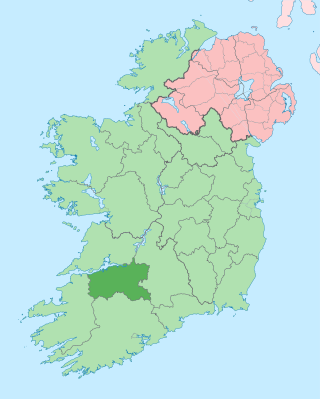
County Limerick is a western county in Ireland. It is in the province of Munster and is located in the Mid-West which comprises part of the Southern Region. It is named after the city of Limerick. Limerick City and County Council is the local council for the county. The county's population at the 2022 census was 209,536 of whom 102,287 lived in Limerick City, the county capital.

County Tipperary is a county in Ireland. It is in the province of Munster and the Southern Region. The county is named after the town of Tipperary, and was established in the early 13th century, shortly after the Norman invasion of Ireland. It is Ireland's largest inland county and shares a border with eight counties, more than any other. The population of the county was 167,895 at the 2022 census. The largest towns are Clonmel, Nenagh and Thurles.

Clan Campbell is a Highland Scottish clan, historically one of the largest and most powerful of the Highland clans. The Clan Campbell lands are in Argyll and within their lands lies Ben Cruachan. The chief of the clan became Earl of Argyll and later Duke of Argyll.
Ballyfin is a small village and parish in County Laois, Ireland. Located in the Slieve Bloom Mountains, the village is in the midlands of Ireland. It is around 8 km west of Portlaoise, on the R423 road between Mountrath and Mountmellick.

The Kingdom of Desmond was a historic kingdom in southwestern Ireland. It was founded in 1118 by Tadhg Mac Cárthaigh, King of Munster when the Treaty of Glanmire formally divided the Kingdom of Munster into Desmond and Thomond. It comprised all of what is now County Cork and most of County Kerry. Desmond was ruled by the Mac Cárthaigh (MacCarthy) dynasty. Other clans within the kingdom included the O'Sullivans and O'Donovans. Following the Norman invasion of Ireland in the late 12th century, the eastern half of Desmond was conquered by the Anglo-Normans and became the Earldom of Desmond, ruled by the Fitzmaurices and FitzGeralds—the famous Irish family known as the Geraldines. The king of Desmond, Diarmaid Mac Cárthaigh submitted to Henry II of England, but the western half of Desmond lived on as a semi-independent Gaelic kingdom. It was often at war with the Anglo-Normans. Fínghin Mac Carthaigh's victory over the Anglo-Normans at the Battle of Callann (1261) helped preserve Desmond's independence. The kings of Desmond founded sites such as Blarney Castle, Ballycarbery Castle, Muckross Abbey and Kilcrea Friary. Following the Nine Years' War of the 1590s, Desmond became part of the Kingdom of Ireland.

Askeaton is a town in County Limerick, Ireland. The town is built on the banks of the River Deel which flows into the Shannon Estuary 3 km to the north. Askeaton is on the N69 road between Limerick and Tralee; it is 25 km west of Limerick and 8 km north of Rathkeale.
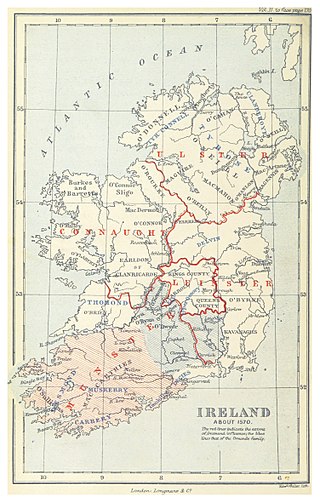
The Desmond Rebellions occurred in 1569–1573 and 1579–1583 in the Irish province of Munster. They were rebellions by the Earl of Desmond, the head of the FitzGerald dynasty in Munster, and his followers, the Geraldines and their allies, against the threat of the extension of the English government over the province. The rebellions were motivated primarily by the desire to maintain the independence of feudal lords from their monarch but also had an element of religious antagonism between Catholic Geraldines and the Protestant English state. They culminated in the destruction of the Desmond dynasty and the plantation or colonisation of Munster with English Protestant settlers. 'Desmond' is the Anglicisation of the Irish Deasmumhain, meaning 'South Munster'.

O'Sullivan is an Irish Gaelic clan based most prominently in what is today County Cork and County Kerry. According to traditional genealogy, the O’Sullivans were descended from the ancient Eóganacht Chaisil sept of Cenél Fíngin, the founder of the clan who was placed in the 9th century, eight generations removed from Fíngen mac Áedo Duib, king of Cashel or Munster from 601 to 618. Later, they became the chief princes underneath their close kinsmen, the MacCarthy dynasty, in the small but powerful Kingdom of Desmond, successor of Cashel/Munster. The last independent ruler of the clan was Donal Cam O'Sullivan Beare, who was defeated in the Nine Years' War of 1594–1603.
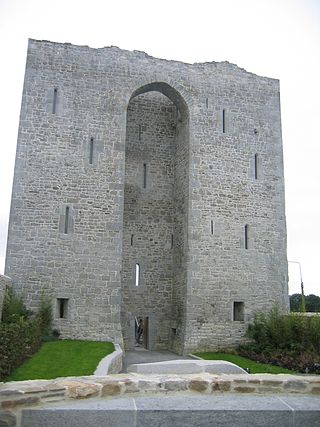
Listowel Castle, located near the town of Listowel, County Kerry in Ireland, was built in the 15th century. The castle is a noted example of Anglo-Norman architecture in County Kerry, and has been the subject of several restoration projects. It is now protected as a national monument, and is open to the public for tours on a daily basis.

Dunkerron Castle is a ruined four-storey tower house located in Templenoe, near Kenmare, County Kerry, in south-west Ireland. The castle was the family seat of the O'Sullivan Mór family from the late 16th century.
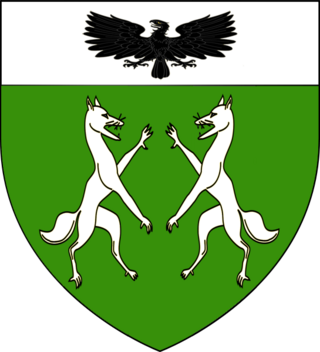
The O'Donoghue of the Glens, Prince of Glenflesk, is the hereditary chieftain of his sept of the Kerry Eóganacht, Munster, Ireland. In 1944, his father was one of the few Chiefs of the Name recognized by Edward MacLysaght, the first Chief Herald, as having a verifiable pedigree and entitled to use the title and receive courtesy recognition by the Irish State.
Richard Butler of Kilcash (1615–1701) was an Irish soldier and landowner, the third son of Thomas Butler, Viscount Thurles and brother of James, 1st Duke of Ormonde. He sided with the Irish Confederacy at the Irish Rebellion of 1641. He scouted the enemy on the morning of the Battle of Cloughleagh. His descendants succeeded to the earldom of Ormond when the senior branch of the family failed in 1758.

Moorstown Castle is a late 15th-century stone structure consisting of an enclosed circular keep near Clonmel, County Tipperary, Ireland.

The Lordship of Coshmaing is an historic honorific title associated with the Gaelic nobility of Ireland. The title was created in the 14th century when the then King of Desmond, granted an appanage to one of his sons. As with other such titles in Ireland, it no-longer has any recognition under the law, and has not been used for several hundred years.

The Gaelic-Irish Lordship of Molahiffe was created in the 14th century by Eóghan (Owen) Mór MacCarthy, Lord of Coshmaing, as a grant to his son, Donal. Molahiffe Castle was also the seat of The Paramount Lordship of Cosmaigne. The Gaelic title, Lord (Tiarna/Baron) of Molahiffe, should not be confused with the Baronetcy of Molahiffe, which was an English title held by some of the Browne family after they took possession of former MacCarthy lands at the beginning of the seventeenth century. Alternate spellings of Molahiffe include "Mullahiffe," and, "Moylahiffe."
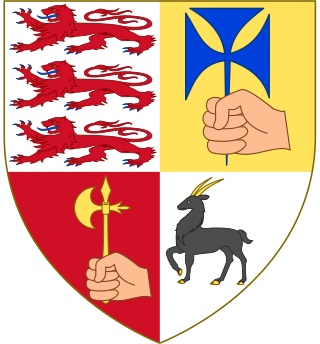
The McGrath family is an Irish clan. The name is derived from the Gaelic Mac Craith, recorded in other written texts as Mag Craith, Mag Raith and Macraith, including the Annals of the Four Masters and the Annals of Ulster. McGrath is a surname of ancient Irish origin, and is borne by the descendants of a number of septs, each with a common origin in the Kingdom of Thomond, a kingdom that existed before the Norman invasion and was located in north Munster.

Castlefreke, also known as Rathbarry, is a townland and village in County Cork, Ireland. The townland is located in the civil parish of Rathbarry on the R598 regional road, to the east of Rosscarbery.

Togher Castle, is a late 16th century tower house primarily known for its association with the MacCarthys of Gleannacroim. It is located approximately 9 kilometres (5.6 mi) north of the town of Dunmanway in the townland of Togher, which derives from the Irish "tóchar" meaning "causeway", or "causeway of wood over a bog".

Carrignacurra Castle is a stone-built tower house constructed in County Cork, Ireland, as the chief seat of the O'Leary family. It was built to defend a ford across the River Lee about 1.5 km east of Inchigeelagh village, on a historic route between Macroom and Dunmanway. The name, Carrignacurra, probably comes from Carraig na Choradh - Rock of the Weir.

















